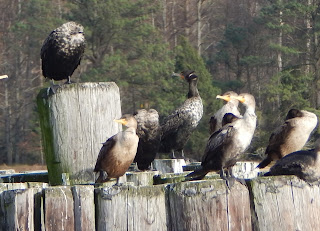Below are three photos of different-sized cormorants: the top one shows a small cormorant on the left, with yellow-orange skin above and below the beak next to a "typical" Double-crested; note the small bird's very small beak and legs and feet; the middle photo shows the 3 sizes in the same posture; the bottom photo shows the large bird on the right with the heavy head, thick beak, thick, brown neck and body structure like a Great Cormorant, but with yellow-orange skin above and below the beak, as with Double-crested and with no white on throat or cheek, as typical for Great, though an apparent second winter Great. While there can certainly be some individual size and plumage variation, these examples seem, from my experience, to be well outside the norm. I have not yet researched hybridization examples...Neoptropic X Double-crested?... though the small bird is a good candidate for a hybrid and I welcome any comments. I saw them today at the Jamestown ferry dock.
Brian Taber




